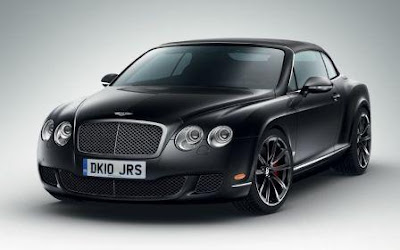
2011 Bentley's Continental GTC is the convertible version of the automaker's Continental GT coupe. A performance model, called GTC Speed, debuted in 2009. Exterior features include:
Interior
The GTC can seat up to four people on front and rear bucket seats, though the rear seats would likely only be comfortable for children.
Continental GTC Speed
The twin-turbo W-12 can go from zero to 60 mph in 4.5 seconds and reach a maximum
More substantively, the 2011 Conti gets a boost in horsepower from its 6.0-liter twin-turbo W12 engine, hitting 567 horsepower and 516 pound-feet. To keep that power in the right place, the rear track is wider, front-to-rear bias of the all-wheel-drive system is now 40/60 front-to-rear, and the coefficient of drag has been reduced to 0.33. 0-60 mph? Top speed? 198 mph.
Joining that are a sleeker dash, climate-controlled "Cobra" seats sculpted to provide more rear legroom, and leather-lined door pouches with water bottle holders. It's everything the current Continental GT is.
When the last-generation Continental GT debuted in 2003, it proved surprisingly popular—not because the grand touring coupe wasn’t exceptional, but because it wasn’t cheap.
The Continental GT is not only a modern icon, it’s also largely responsible for changing the image of the brand from stodgy to sporting. (A small percentage of the population knows that Bentley won Le Mans in 2003, a much larger percentage knows about Bentley because of its top seller.)
The message behind these changes has carried over into the car’s performance, which has improved due to three key factors: more engine, less weight, more refinement.
While the twin-turbocharged 6.0-litre W12 engine of the original model was powerful (406 kW; 649 Nm), the new version is even more so (423 kW; 700 Nm). A quick blast along the desert roads of Oman proved that the new Continental GT represents a marked improvement. The revised 6-speed automatic transmission shifts gears in half the time, giving the Bentley a distinctly racier feeling compared to the original (although it’s still no dual-clutch speedster.)
The top speed claim could not be verified—at 210 km/h, a message on the instrument panel warned that the tires weren’t properly inflated for such speeds. It turns out that the technicians had prepared the coupe for comfortable touring not edge-of-your-seat drag racing.
The all-wheel drive system now features a basic 40/60 torque split (front/rear), which has carried over from the outgoing, high-performance Continental Supersports model. Of course, the traction control system varies the torque distribution if it detects wheel slippage at the back. As an everyday driver, the Continental GT is definitely more than a little intimidating: It’s big, it’s fast and it’s expensive. The Continental GT is a true 2+2 coupe, meaning that the back seat is suitable only for small children.
The front seats were also made lighter, in part by moving the seat-belt mechanism to the car’s B-pillar. The seats are sporty and supportive.
All things considered, the Continental GT is a more mature, higher-performing and more engaging version of its predecessor.
Labels: Bentley










0 comments:
Post a Comment